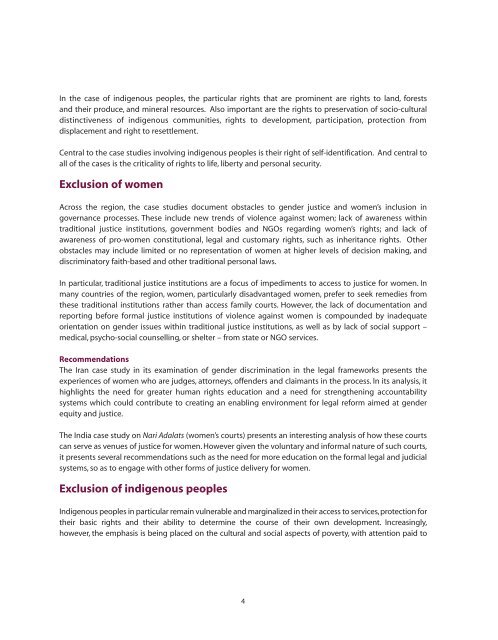View / Download - HRBA Portal
View / Download - HRBA Portal
View / Download - HRBA Portal
Create successful ePaper yourself
Turn your PDF publications into a flip-book with our unique Google optimized e-Paper software.
In the case of indigenous peoples, the particular rights that are prominent are rights to land, forestsand their produce, and mineral resources. Also important are the rights to preservation of socio-culturaldistinctiveness of indigenous communities, rights to development, participation, protection fromdisplacement and right to resettlement.Central to the case studies involving indigenous peoples is their right of self-identification. And central toall of the cases is the criticality of rights to life, liberty and personal security.Exclusion of womenAcross the region, the case studies document obstacles to gender justice and women’s inclusion ingovernance processes. These include new trends of violence against women; lack of awareness withintraditional justice institutions, government bodies and NGOs regarding women’s rights; and lack ofawareness of pro-women constitutional, legal and customary rights, such as inheritance rights. Otherobstacles may include limited or no representation of women at higher levels of decision making, anddiscriminatory faith-based and other traditional personal laws.In particular, traditional justice institutions are a focus of impediments to access to justice for women. Inmany countries of the region, women, particularly disadvantaged women, prefer to seek remedies fromthese traditional institutions rather than access family courts. However, the lack of documentation andreporting before formal justice institutions of violence against women is compounded by inadequateorientation on gender issues within traditional justice institutions, as well as by lack of social support –medical, psycho-social counselling, or shelter – from state or NGO services.RecommendationsThe Iran case study in its examination of gender discrimination in the legal frameworks presents theexperiences of women who are judges, attorneys, offenders and claimants in the process. In its analysis, ithighlights the need for greater human rights education and a need for strengthening accountabilitysystems which could contribute to creating an enabling environment for legal reform aimed at genderequity and justice.The India case study on Nari Adalats (women’s courts) presents an interesting analysis of how these courtscan serve as venues of justice for women. However given the voluntary and informal nature of such courts,it presents several recommendations such as the need for more education on the formal legal and judicialsystems, so as to engage with other forms of justice delivery for women.Exclusion of indigenous peoplesIndigenous peoples in particular remain vulnerable and marginalized in their access to services,protection fortheir basic rights and their ability to determine the course of their own development. Increasingly,however, the emphasis is being placed on the cultural and social aspects of poverty, with attention paid to4



